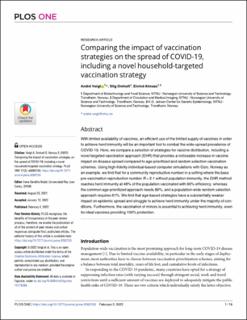| dc.contributor.author | Voigt, Andre | |
| dc.contributor.author | Omholt, Stig William | |
| dc.contributor.author | Almaas, Eivind | |
| dc.date.accessioned | 2022-12-01T08:34:17Z | |
| dc.date.available | 2022-12-01T08:34:17Z | |
| dc.date.created | 2022-01-28T08:45:04Z | |
| dc.date.issued | 2022 | |
| dc.identifier.issn | 1932-6203 | |
| dc.identifier.uri | https://hdl.handle.net/11250/3035195 | |
| dc.description.abstract | With limited availability of vaccines, an efficient use of the limited supply of vaccines in order to achieve herd immunity will be an important tool to combat the wide-spread prevalence of COVID-19. Here, we compare a selection of strategies for vaccine distribution, including a novel targeted vaccination approach (EHR) that provides a noticeable increase in vaccine impact on disease spread compared to age-prioritized and random selection vaccination schemes. Using high-fidelity individual-based computer simulations with Oslo, Norway as an example, we find that for a community reproductive number in a setting where the base pre-vaccination reproduction number R = 2.1 without population immunity, the EHR method reaches herd immunity at 48% of the population vaccinated with 90% efficiency, whereas the common age-prioritized approach needs 89%, and a population-wide random selection approach requires 61%. We find that age-based strategies have a substantially weaker impact on epidemic spread and struggle to achieve herd immunity under the majority of conditions. Furthermore, the vaccination of minors is essential to achieving herd immunity, even for ideal vaccines providing 100% protection. | en_US |
| dc.language.iso | eng | en_US |
| dc.publisher | Public Library of Science | en_US |
| dc.rights | Navngivelse 4.0 Internasjonal | * |
| dc.rights.uri | http://creativecommons.org/licenses/by/4.0/deed.no | * |
| dc.title | Comparing the impact of vaccination strategies on the spread of COVID-19, including a novel household-targeted vaccination strategy | en_US |
| dc.title.alternative | Comparing the impact of vaccination strategies on the spread of COVID-19, including a novel household-targeted vaccination strategy | en_US |
| dc.type | Peer reviewed | en_US |
| dc.type | Journal article | en_US |
| dc.description.version | publishedVersion | en_US |
| dc.source.volume | 17 | en_US |
| dc.source.journal | PLOS ONE | en_US |
| dc.source.issue | 2 | en_US |
| dc.identifier.doi | 10.1371/journal.pone.0263155 | |
| dc.identifier.cristin | 1991954 | |
| cristin.ispublished | false | |
| cristin.fulltext | original | |
| cristin.qualitycode | 1 | |

